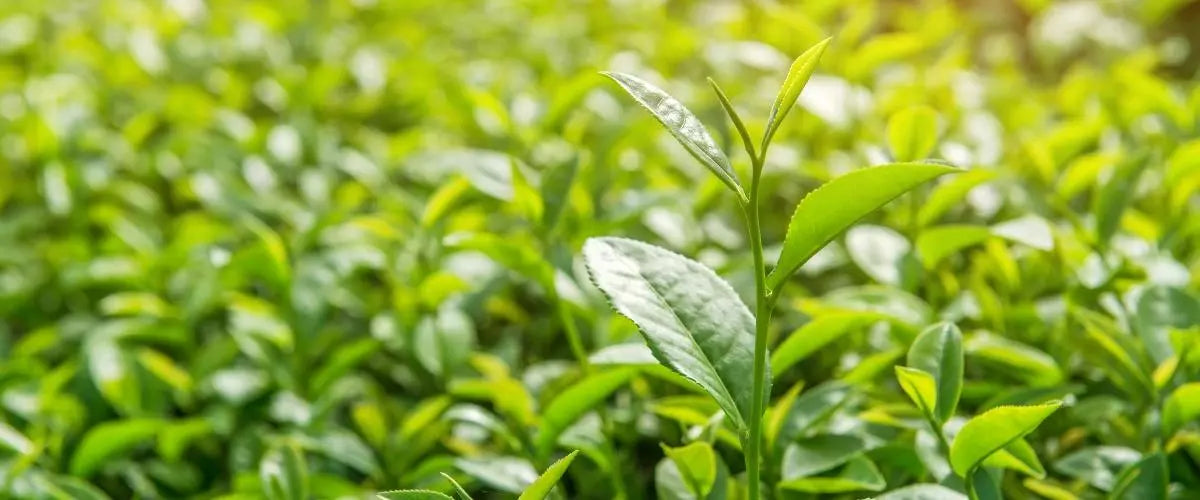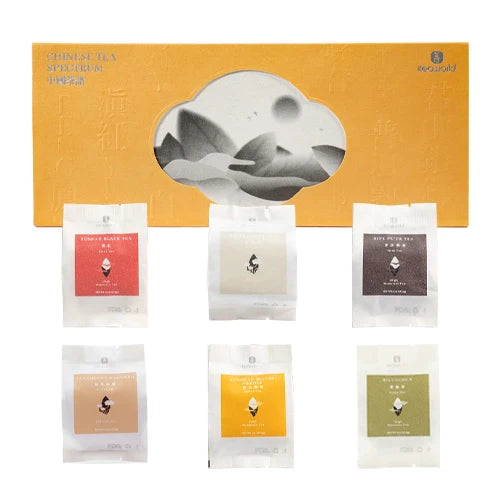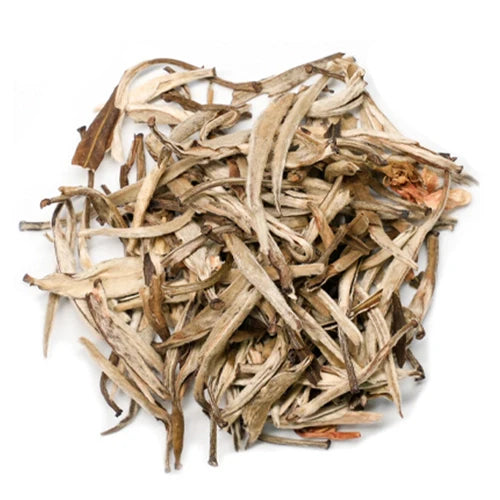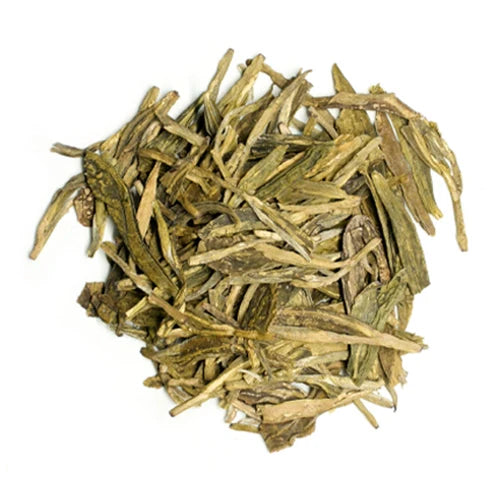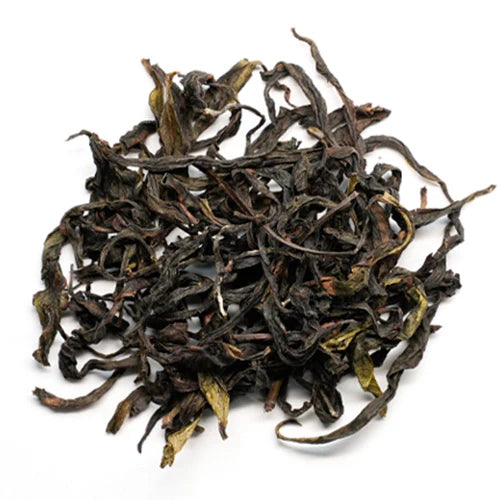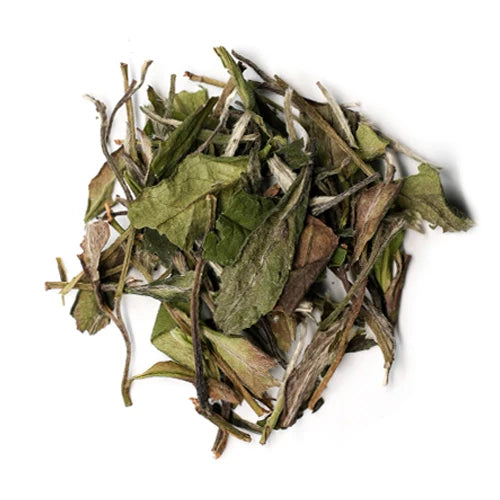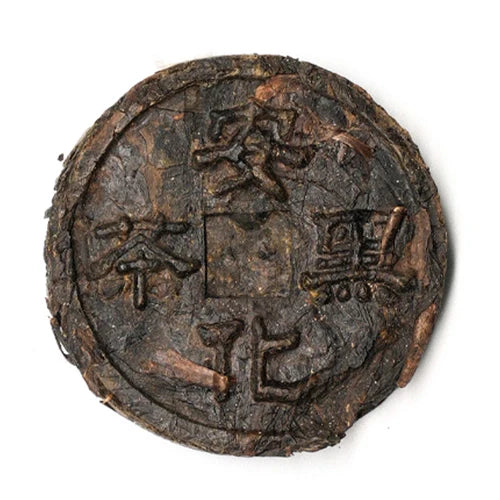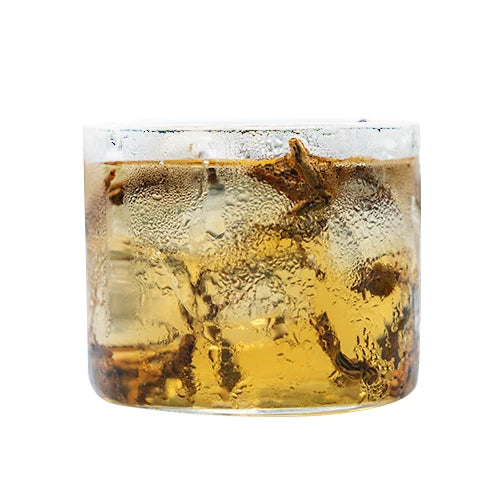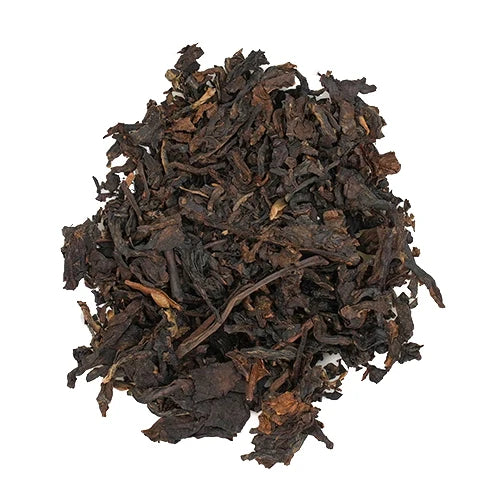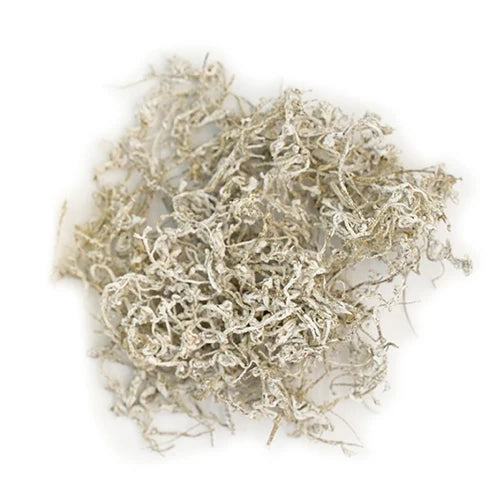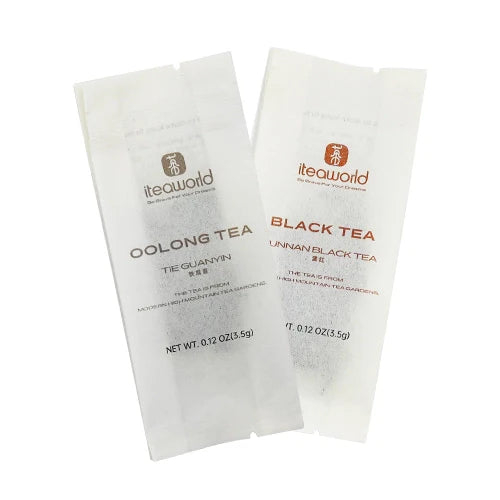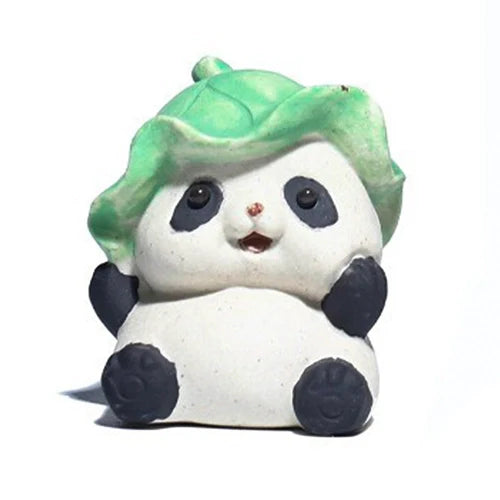Learn About Famous Oolong Teas
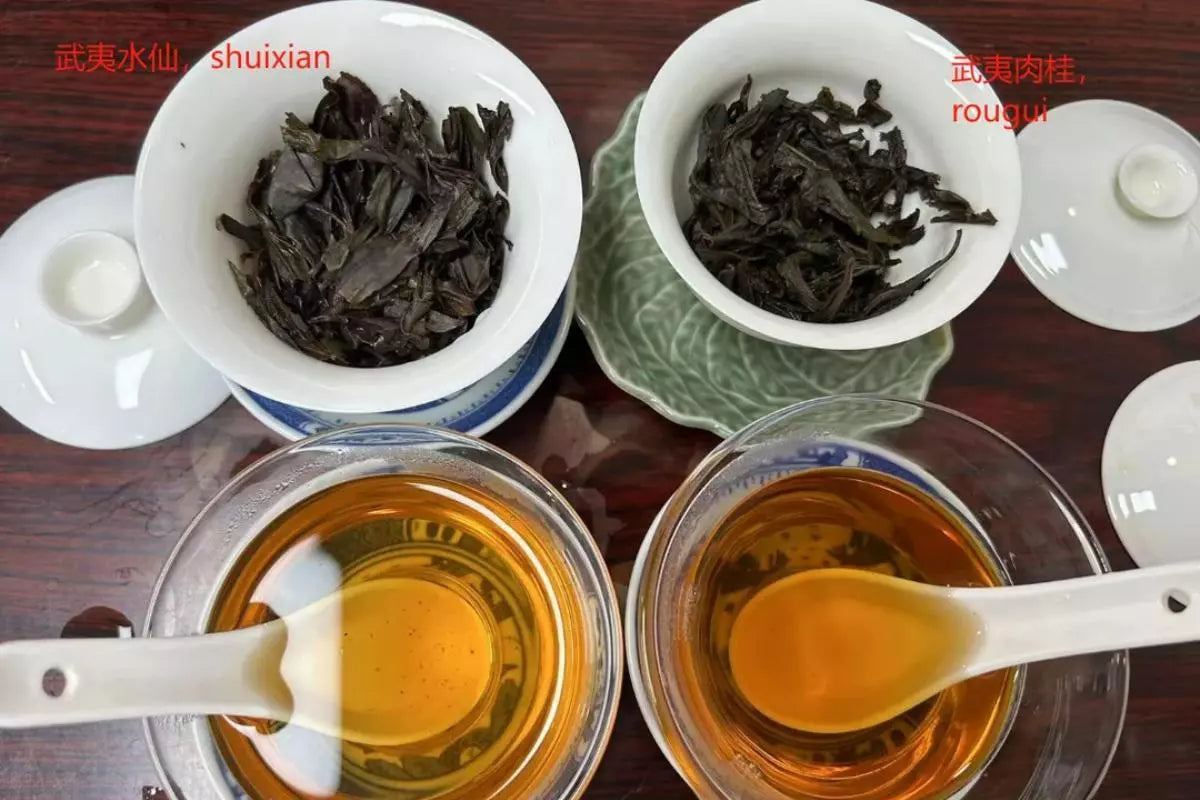
Exploring Wuyi Yancha: The King of Oolong Teas
If you’re a tea enthusiast, you’ve likely encountered the unique flavors of oolong tea. But there’s one category that stands out among the rest: Wuyi Yancha. Revered as the "king of oolongs," Wuyi Yancha is a treasure from the Wuyi Mountains, located in China’s Fujian province. Known for its distinct “rock charm” or yan yun, this tea is cultivated in the rich, mineral-laden soil of the Wuyi Mountains Nature Reserve. The result? A tea with deep, complex flavors and a history that spans centuries.
Among the myriad varieties of Wuyi Yancha, Da Hong Pao, Wuyi Shuixian (Water Sprite), and Wuyi Rougui (Cinnamon) are some of the most famous. Today, let’s leave Da Hong Pao aside and dive into the other two—Shuixian and Rougui—which represent the foundation of this exquisite tea category.
1. Appearance of Dry Leaves
Wuyi Shuixian: This tea is made from a small tree species with notably large leaves. The older the tree, the higher the tea quality, and the leaves are typically harvested using a method known as "open face picking." This technique involves plucking 3–4 leaves while leaving the bud intact. The result is larger, thicker leaves that are also more tender than Rougui. These leaves create a unique texture and flavor that is prized by tea lovers, and it’s exactly what you’ll find in iTeaworld’s Wuyi Shuixian. This exceptional tea captures the essence of its heritage and craftsmanship, offering a taste of the true Wuyi Mountains.
Wuyi Rougui: Rougui comes from a shrub variety with smaller, oval-shaped leaves. The harvesting technique usually involves picking fully mature leaves, resulting in a more mature, compact leaf compared to Shuixian. These leaves offer a more robust and intense flavor, which is one of the reasons Rougui has earned its reputation for boldness and complexity.
2. Aroma of Dry Leaves
While the two teas share similar processing techniques—around 60%-70% oxidation and varying degrees of roasting—their dry aromas are often hard to distinguish. Both teas exude that signature Wuyi fragrance, but the roast level can shift the aroma slightly. If you’re exploring the world of Wuyi Yancha, whether you're sampling Wuyi Shuixian or Wuyi Rougui from iTeaworld, you’ll notice subtle differences in their fragrances that enhance your brewing experience.
3. Brewing Method
When brewing Wuyi Yancha, I prefer using a classic white porcelain gaiwan with boiling water (100°C / 212°F). Here's my go-to method:
First, give the tea a quick rinse to awaken the leaves.
For the second infusion, steep for 8–10 seconds to capture the tea’s core flavors. Wuyi Yancha, like iTeaworld’s Wuyi Rougui, should not be steeped too long—oversteeping can make it bitter.
For infusions 3–5, steep for about 15 seconds, and for infusions 6–10, extend the steeping time to 20–30 seconds. Wuyi Yancha, especially Wuyi Shuixian, is incredibly resilient and can handle multiple infusions while maintaining its rich, nuanced flavor.
4. Flavor Profile
In China, teas are often likened to personalities, and Wuyi Yancha is no exception. The two teas we’re discussing—Shuixian and Rougui—each bring something unique to the table:
Wuyi Rougui: Bold, intense, and spicy, Rougui is often compared to a strong, masculine energy. Its flavor profile includes a sharp, stimulating spiciness that lingers on the palate, accompanied by a subtle sweetness in the aftertaste. It’s the perfect choice for those who enjoy a bold and fiery tea. In fact, iTeaworld’s Wuyi Rougui has been crafted to deliver just that—a tea that both excites and soothes in every sip.
Wuyi Shuixian: On the other hand, Shuixian offers a smoother, more mellow experience. Often described as having a gentle, feminine charm, the tea features a delicate balance of floral and woody notes that linger softly on the palate. It’s calming, easy to sip, and perfect for a relaxing tea session. iTeaworld’s Wuyi Shuixian embodies this smooth, elegant flavor profile, making it a go-to choice for tea drinkers seeking a subtle yet deeply satisfying cup.
The flavor differences between these two teas can be attributed not only to the plant variety but also to the way they’re processed:
Shuixian is gently shaken five times during oxidation, each time with 600 rotations.
Rougui, however, undergoes a more intense shaking process—6–8 rounds of shaking, with each round increasing the number of rotations. This more robust processing brings out Rougui’s deeper, spicier flavors, making it a tea that packs more punch.
My Preference
Personally, I lean towards Wuyi Shuixian. Its smooth, lingering aroma and refined taste create the perfect atmosphere for a relaxed tea session. On the other hand, the boldness and spice of Rougui can be a little too stimulating for me at times. However, I can understand why some people prefer the strong, invigorating kick that Rougui offers.
But what about you? Do you gravitate towards the gentle, enduring fragrance of Shuixian, or do you love the strong, spicy kick of Rougui? If you haven’t yet tried iTeaworld’s Wuyi Shuixian or Wuyi Rougui, I highly recommend giving them a try. These teas offer a perfect introduction to the world of Wuyi Yancha and showcase the exceptional craftsmanship that goes into every batch.
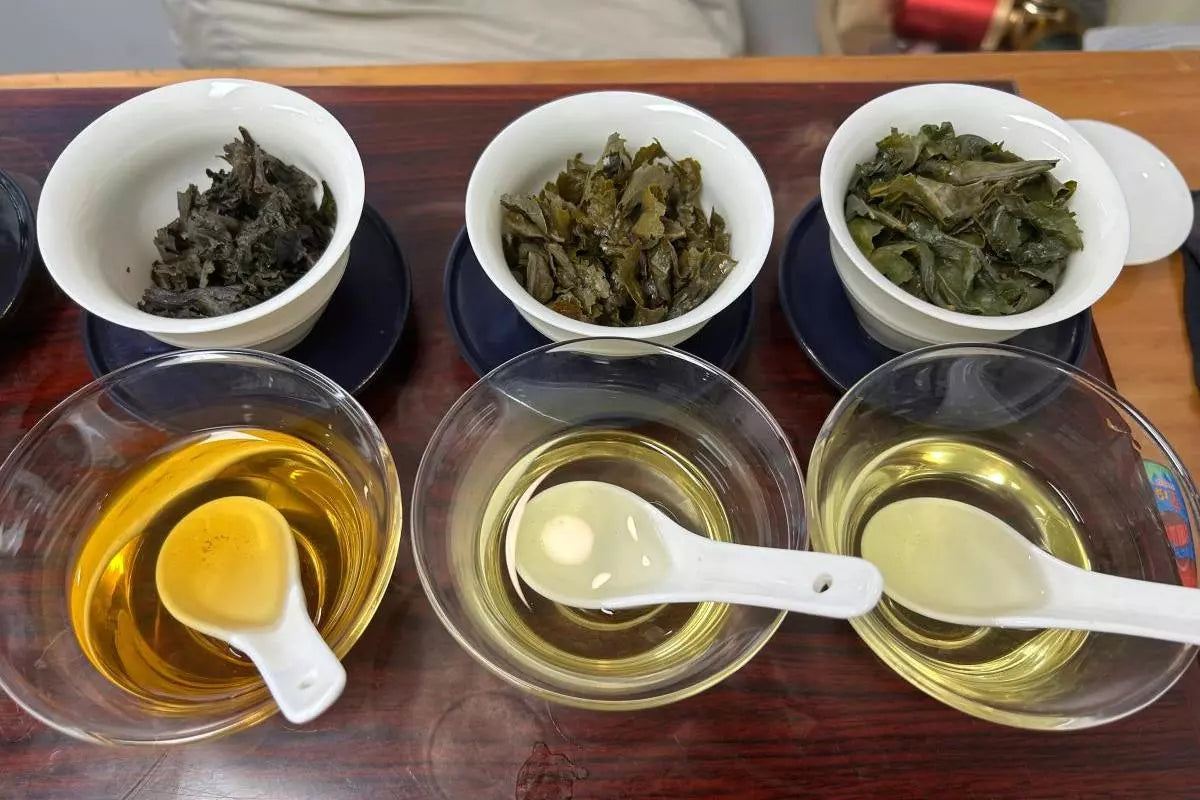
Tieguanyin: Unveiling the Three Types of Exquisite Oolong Tea
Have you ever wondered what makes Tieguanyin tea so special? Perhaps you’ve tasted its smooth, floral flavor, but did you know there are different types of Tieguanyin tea, each with its own story, aroma, and flavor profile? From Light Aroma to Aged Aroma, Tieguanyin offers a world of variety that is as captivating as the tea itself.
The Origins of Tieguanyin
Tieguanyin, also known as Iron Goddess of Mercy, originates from Anxi County in Fujian Province, China. This iconic oolong tea combines centuries of tradition with meticulous craftsmanship. Its name reflects both its elegant flavor and the legend of compassion that surrounds its discovery. Today, Tieguanyin is celebrated worldwide for its exquisite taste and cultural significance.
Now, Anxi Tieguanyin is protected as a product of the original geographical indication. According to the national standards, Anxi Tieguanyin is produced within the administrative region under the jurisdiction of Anxi County, Fujian Province.
Under the natural ecological conditions within Anxi County, fresh leaves are selected from the Tieguanyin tea tree variety (yes, Tieguanyin is the name of the tea tree variety) for propagation by cuttings, cultivation and picking, and then processed through a unique traditional technique. It is an oolong tea with the characteristic features and quality of the Tieguanyin variety. The finished tea is classified into the light fragrance type and the strong fragrance type.
Types of Tieguanyin Tea
1. Light Aroma Tieguanyin (Qing Xiang)
Light Aroma Tieguanyin comes in two main variations:
Modern Light Aroma: With very low oxidation, this version emphasizes a fresh, orchid-like floral fragrance. Its inspiration comes from Taiwanese oolong tea, appealing to younger drinkers who love vibrant and aromatic teas.
Traditional Zheng Wei Tieguanyin: Known as the "authentic" Anxi-style Tieguanyin, it undergoes light roasting. This method creates a balanced tea where floral notes harmonize with a rich, satisfying body.
How to choose? If you adore bright, floral fragrances and have a healthy stomach, modern Light Aroma is ideal. For a more rounded experience, Traditional Zheng Wei is better—it’s aromatic yet gentle on the stomach.
2. Strong Aroma Tieguanyin (Nong Xiang)
This traditional style has medium oxidation and roasting, creating a tea with a toasty, malty fragrance and a robust flavor. Historically, this method allowed Tieguanyin to withstand long journeys when exported. Strong Aroma Tieguanyin is perfect for those who enjoy depth and complexity in their tea.
3. Aged Aroma Tieguanyin (Chen Xiang)
Aged Tieguanyin undergoes years of aging and controlled roasting, developing a smoother, mellower taste. Over time, its character evolves into something truly special. This version is perfect for those with sensitive stomachs or anyone who enjoys soothing, warming teas. Boiling aged Tieguanyin unlocks its deep, complex flavors. Generally, at least 10 years of aging is required to achieve its signature taste.
How to Identify Different Tieguanyin Types
Light Aroma: Bright green dry leaves with minimal oxidation. The tea soup is honey green in color, with a fresh, sweet and refreshing taste. The image is distinct, but the red edges on the leaves are not obvious.
Strong Aroma or Aged Aroma: Darker leaves, often brown or charcoal-colored, indicating higher oxidation and roasting levels.The aroma is rich and floral. The tea soup is golden yellow in color, with a thick, smooth and refreshing taste. The leaves at the bottom of the cup are soft, bright and have red edges.
When buying Tieguanyin, take note of the leaves’ color and aroma. Each style offers a distinct tea experience, so choose based on your flavor preferences.
The Magic of Tieguanyin
Tieguanyin isn’t just a tea—it’s an experience. With every sip, you’re tasting the dedication and skill of tea masters who have perfected their craft over generations. Whether you prefer the fresh florals of Light Aroma, the comforting depth of Strong Aroma, or the mellow smoothness of Aged Aroma, there’s a Tieguanyin for everyone.
Explore Tieguanyin with Iteaworld
For a premium Tieguanyin experience, explore the carefully curated selection at Iteaworld. Our teas are sourced from the finest tea gardens in Anxi and beyond, ensuring authentic flavors and exceptional quality. Whether you’re a seasoned tea lover or just beginning your journey into the world of oolong tea, Iteaworld offers the perfect Tieguanyin to suit your taste.
A Journey Worth Taking
Discovering Tieguanyin tea is like embarking on a journey through tradition, flavor, and artistry. Each cup tells a story of nature’s beauty and human dedication. Whether you’re sharing a pot with friends or enjoying a quiet moment alone, Tieguanyin brings warmth, peace, and joy to every occasion.

The Difference of Oolong Tea Taste Between Four Shui Xian Oolong Teas
Exploring the World of Shui Xian Oolong Tea
Shui Xian Oolong tea is a beloved tea variety that holds a prominent place in the world of Chinese teas. But with its many types and variations, it’s no surprise that people might wonder: What exactly makes Shui Xian oolong tea flavor so special?
In this post, we’ll explore the differences between four well-known Shui Xian Oolong teas from China’s Fujian and Guangdong regions: Phoenix Shui Xian from Guangdong, and Wuyi Shui Xian, Minnan Shui Xian, and Zhangping Shui Xian from Fujian. These four variants have distinct histories, flavors, and characteristics that set them apart, offering a wonderful range of experiences for tea lovers.
Phoenix Shui Xian: A Glimpse into Guangdong’s Rich Heritage
Phoenix Shui Xian originates from Fenghuang Town in Guangdong Province, an area famous for its unique approach to tea cultivation. The tea is made from seed-propagated local tea trees, initially cultivated from wild "Hong Yin" tea trees.
One of the standout features of Phoenix Shui Xian is its minimal oxidation process—unlike most oolong teas, which are oxidized to varying degrees, traditional Phoenix Shui Xian skips this process, making it closer to raw tea in style. This allows the tea to retain a fresh and fragrant aroma that reminds many of green tea, while still offering the complexity that oolong tea drinkers cherish.
In recent years, modern production methods may not strictly follow the traditional non-oxidized style, but the tea still retains its distinctive flavor. Phoenix Shui Xian is known for its fruity and floral notes, with a refreshing aftertaste that lingers on the palate.
Zhangping Shui Xian: Lightly Roasted with Delicate Floral Notes
Zhangping Shui Xian is another popular variety of Shui Xian tea, but it comes from the Fujian region, specifically Zhangping. This variety is known for being lightly to medium roasted, with oxidation levels slightly higher than that of floral-style Tie Guan Yin.
What makes Zhangping Shui Xian so unique is its distinctive packaging and processing method—it is often wrapped in paper and roasted, which gives it an elegant floral aroma reminiscent of orchids and gardenias.
The flavor profile of Zhangping Shui Xian is delicate and smooth, with a clean, sweet taste that is perfect for those who enjoy lighter oolong teas. Its subtlety and balance make it an ideal choice for those new to Shui Xian or those who appreciate a gentler oolong experience.
Minnan Shui Xian: A Fusion of Wuyi and Lighter Processing
Minnan Shui Xian, as the name suggests, hails from the Minnan region of Fujian Province, an area known for its tea craftsmanship. This variety was introduced from Wuyi Mountain and is processed using Wuyi-style techniques. However, Minnan Shui Xian undergoes lighter fermentation and roasting, making it distinct from the heavier, more robust Wuyi Rock Teas.
This tea offers a rich, smooth texture with subtle woody and floral aromas. While it doesn’t possess the intense fragrance of some other Shui Xian varieties, it provides a fuller, more robust liquor with a deep, satisfying taste. It’s a great option for those who enjoy a well-balanced, rich tea that isn’t overly floral or aromatic.
Wuyi Shui Xian: The Star of Wuyi Rock Tea
Wuyi Shui Xian is arguably the most famous and sought-after of all Shui Xian teas. Hailing from the prestigious Wuyi Mountains in Fujian, this tea is a prime example of the famed Wuyi Rock Tea (Yan Cha) category. It is known for its heavier oxidation and roasting, which result in a deep, complex flavor profile that features rich, baked sweet potato and ripe fruit notes.
The tea is full-bodied, smooth, and thick, with a remarkable balance between the roasted notes and the natural flavors of the tea. It is a great option for those who appreciate a robust tea with a distinct minerality, often described as "rock flavor" or "Yan Yun" in tea circles.
How to Choose the Right Shui Xian Tea
When choosing the right Shui Xian tea, consider your preferences and the type of tea experience you want:
If you love light floral teas, Zhangping Shui Xian is a must-try. Its delicate aroma and smooth texture make it a top pick, especially if you’re already a fan of lightly oxidized Tie Guan Yin.
For those who enjoy rich, roasted flavors, Wuyi Shui Xian is the clear winner. This variety showcases the exceptional craftsmanship of Wuyi Rock Tea processing, with a harmonious depth of flavor and aroma.
If you’re looking to explore the most floral and aromatic oolong teas, Phoenix Dan Cong is the way to go. This exceptional tea comes from the Phoenix Shui Xian varietal, a local group of tea trees that have been vegetatively propagated into elite single-bush selections. Each tea bush produces its own unique natural aroma, offering a wide range of flavor experiences.
Conclusion: A Tea for Every Taste
Choosing a Shui Xian tea can be a delightful journey, as each type offers something unique to the tea connoisseur. Whether you’re seeking the delicate floral notes of Zhangping Shui Xian or the deep, roasted flavors of Wuyi Shui Xian, there’s a Shui Xian variety for every preference. As you explore these different teas, remember that the world of Shui Xian is as diverse as the regions it comes from.
Trust in Quality, Trust in Iteaworld
If you’re looking to experience the best of Shui Xian tea, Iteaworld offers premium selections that showcase the craftsmanship and dedication of Chinese tea makers. Our Shui Xian Oolong teas are carefully curated to provide the perfect balance of flavor, aroma, and authenticity. Whether you’re a long-time tea enthusiast or a newcomer to Oolong, Iteaworld’s collection promises an unforgettable experience with every cup.

10 Best Chinese Loose Leaf Oolong Teas of 2025
Loose leaf Oolong tea, also known as “Qingcha”, is a type of semi-fermented tea originating from the Ming and Qing dynasties in China. Developed by Anxi tea farmers based on the green tea-making method, loose leaf Oolong tea first spread to northern Fujian and Guangdong before making its way to Taiwan.Among the various types of Chinese teas, loose leaf Oolong tea stands out as a distinctive category, earning the reputation of "green leaves with red edges." It is highly acclaimed for its unique aroma and flavor.For those interested in trying loose leaf Oolong tea, they will discover a wide variety of options. If you are intrigued by loose leaf Oolong tea but lack sufficient knowledge, how can you choose the right one? We recommend exploring your preferences by purchasing tea sampler of Oolong tea. Below, we have selected 10 renowned loose leaf Oolong teas for your reference.
Introduction to the 10 Best Loose Leaf Oolong Teas
1. Tie Guan Yin
Tieguanyin oolong tea is one of the representatives of loose leaf Oolong tea, primarily produced in the western part of Anxi County, Fujian Province, known as "Inner Anxi." The dry tea leaves of TieGuanyin are tightly curled, robust, and exhibit a sandy green luster, resembling a spiral. Known for its strong and uplifting aroma, TieGuanyin is reputed to have "more than seven infusions of lingering fragrance." It is also believed to possess anti-aging properties, clear heat, and aid in refreshing the mind.
2. Da Hong Pao
Da Hong Pao oolong is renowned as the "king of Wuyi tea" and the "top scholar among teas." The tightly twisted appearance of Da Hong Pao's leaves displays a glossy, dark green-brown color. The dry tea leaves emit a pure and authentic fragrance. When brewed, Da Hong Pao yields a clear and orange-hued tea liquor with a rich and refreshing aroma. The taste is sweet, smooth, and delightful. What distinguishes Da Hong Pao's quality is its rich and enduring fragrance, often described as having a prominent "rock charm."
Beyond Da Hong Pao, Wuyi Mountain offers many other celebrated rock teas. You can explore them in our Wuyi Rock Tea guide.
3. Dongding Oolong
Dongding Oolong hails from Lugu Township in Taiwan, named after its production area on Dongding Mountain. This high-quality tea is well-known in Taiwan, with limited production and a relatively high price. When brewed, Dongding Oolong exhibits a honey-green hue with a hint of golden yellow in the tea liquor. The aroma is elegant, and the taste is rich and sweet.
4. Fenghuang Dancong
Fenghuang Dancong (Phoenix Dan Cong) is a type of tea produced on Fenghuang Mountain in Chaozhou City, Guangdong. Known for its excellent quality, Fenghuang Dancong features robust and straight dry tea leaves with a glossy yellow-brown color. The leaves are adorned with vermilion red dots. After brewing, the tea liquor appears bright yellow and clear, with a unique and enduring fragrance. The taste is rich, mellow, and refreshing, characterized by a distinctive "mountain charm."Try China's top 10 oolong teas with our oolong tea collection.>>>
5. Tie Luo Han
Tie Luo Han tea, developed during the Qing Dynasty's Qianlong period, is produced in the famous Wuyi Mountain in the northern part of Fujian. It thrives and matures in the crevices of rocks. The appearance of Tie Luo Han features tightly twisted leaves with a lustrous green-brown color. When brewed, Tie Luo Han exhibits a bright orange-yellow color, and the leaves display a distinctive beauty with green leaves and red edges.
6. Huangjin Gui
Huangjin Gui originates from the Fujian region and is one of the earliest budding varieties among loose leaf Oolong teas. It is also considered an excellent tea tree variety in China. The aroma of Huangjin Gui resembles the fragrance of cassia flowers. After brewing, the tea liquor takes on a bright golden and translucent color, with a pronounced and uplifting aroma, earning it the nickname "Transcendent Fragrance."
7. Bai Ji Guan
Bai Ji Guan oolong is the exclusive "Dao tea" of Wuyi Mountain. Its unique appearance features leaves in a light green color with white streaks. The tea buds, adorned with fuzz, resemble a crescent moon, giving the appearance of a rooster's comb. The dry Bai Ji Guan tea presents a robust, pale yellow hue with white undertones. When brewed, the tea liquor shines in a bright orange-yellow color, leaving a lingering fragrance on the lips and teeth, with a robust and energetic flavor.
8. Shui Jin Gui
Shui Jin Gui is one of the four famous Ming Cong teas of Wuyi Rock Tea. Its name, meaning "Water Golden Turtle," is derived from the dense and shiny appearance of the tea leaves, resembling a golden-colored turtle. The dry Shui Jin Gui tea displays a glossy green-brown color with thick and lush leaves. The tea liquor is clear, golden-yellow, and the taste is sweet without bitterness or astringency, accompanied by a pronounced and uplifting aroma.
Try Rare Wuyi Rock Teas with Our Oolong Tea Sampler.>>>
9. Zhangping Shuixian
Zhangping Shuixian oolong is the only pressed tea among loose leaf Oolong teas. The production and flavor of Zhangping Shuixian tea cakes are distinctive. Fresh Shuixian tea leaves undergo processes such as Weidiao(sun-withering), Zuoqing(shaking and setting), Shaqing(killing green) and Rounian (rolling) before being pressed into square tea cakes using wooden molds. After meticulous packaging with soft paper and precise charcoal roasting, Zhangping Shuixian tea cakes acquire a unique style and maintain the traditional flavor. The tea liquor of Zhangping Shuixian shines in a clear and golden color, with an elegant fragrance, exuding a subtle osmanthus aroma.
10. Oriental Beauty
Oriental Beauty tea is a unique loose leaf Oolong tea native to Taiwan, China, also known as Pong Fong tea. It is distinguished by its prominent white downy tea buds, earning it the alias White Downy Oolong Tea. Among semi-fermented loose leaf Oolong teas, Oriental Beauty is known for its high level of fermentation. The taste of Oriental Beauty is rich and mellow, leaving a lingering fragrance on the lips and teeth, providing a delightful aftertaste.Try Top 10 Classic Chinese Oolong for Beginners with this Oolong Tea Collecttion.>>>
If you enjoy oolongs like Tieguanyin, Huangjin Gui, or Zhangping Shuixian, explore our Minnan Oolong Collection and experience eight teas in one go>>
How to brew oolong tea?
When it comes to brewing oolong tea, the vessel you choose makes a big difference. Two of the most traditional and effective tools are the gaiwan and the clay teapot. Each offers a unique way to bring out different characteristics of the oolong tea.
1. Brewing with a Gaiwan
A gaiwan is ideal for aroma-focused, lightly flavored teas. Because it doesn’t retain aroma or flavor from previous brews, it allows each tea’s profile to shine through clearly. It’s also easy to control, and perfect for quick, clean pouring.
Why white porcelain?White porcelain gaiwans are clean, smooth, and slightly translucent—making it easy to observe the tea leaves as they unfurl and the liquor as it changes color. They're especially well-suited for beginners exploring all six major types of Chinese tea.
How to brew with a gaiwan:
Warm the gaiwan
Add 6–7g of tea (about a 1:15 ratio)
Wake the aroma — gently smell the warm dry leaves (avoid breathing into the gaiwan)
Rinse the leaves — a quick pour-in, then pour out
First brew — boiling water (100°C), steep for 10 seconds
Look → Smell → Sip
2. Brewing with a Clay Teapot (Yixing)
Clay teapots, especially those made of Yixing purple clay, are great for bolder, more full-bodied oolong teas. Over time, the porous clay absorbs the aroma and essence of the tea, enriching future brews.
Best used for:
Wuyi rock teas (e.g. Da Hong Pao)
Phoenix Dan Cong (e.g. Mi Lan Xiang)
Traditional roasted Tie Guan Yin
How to brew with a clay teapot:
Warm and wake the teapot — rinse the inside and outside with boiling water to heat the vessel and activate the clay’s pores
Add 6–7g of tea (stronger teas can take more)
Rinse the leaves — quick, high pour of boiling water; pour out immediately
Main brew
Use boiling water (100°C)
Pour low along the inner wall of the pot (avoid directly hitting the leaves)
Steep for 15 seconds for the first brew, then add 5 seconds for each additional infusion
Pour out fully; tilt the pot to ensure smooth flow
Taste
What to notice:
Look: Deep amber, slightly oily and clear
Smell: Long-lasting aroma with charcoal and fruity notes
Sip: Rich, full-bodied, with a distinct mineral or mountain character
Potential Health Benefits of Loose Leaf Oolong Tea
Oolong tea benefits weight lossOolong tea has the effect of dissolving fat for weight loss because the main component in the tea, tannins, is closely related to fat metabolism.Compared with black tea and green tea, oolong tea can not only stimulate the activity of pancreatic lipolytic enzymes and reduce the absorption of sugary and fatty foods, but also accelerate the body's calorie production, promote fat burning and reduce the accumulation of abdominal fat. Therefore, oolong tea is the tea of choice for weight loss and fat reduction.Lowering blood lipids: Oolong tea has the ability to prevent and reduce the atherosclerotic effect of lipids in the blood in the aorta. Drinking oolong tea also reduces blood viscosity, prevents red blood cell aggregation, improves blood hypercoagulability, increases blood fluidity, and improves microcirculation. In vitro thrombosis test also shows that oolong tea inhibits the role of thrombosis.Lower blood pressure:A 2004 study noted that drinking oolong tea helped lower high blood pressure. People who drank one cup of tea a day had a 45% greater chance of lowering their blood pressure than others, which could be raised to 65% if they drank two cups. Different studies have shown that oolong tea boosts metabolism and fat burning and improves dietary fat absorption. It contains calorie-burning catechin polyphenol substances, which, in combination with exercise and a balanced diet, can be a great way to promote weight loss.Mentally Energetic:As oolong tea contains caffeine, it is helpful in rejuvenating and maintaining high spirits.These renowned loose-leaf Oolong teas each possess unique flavors and rich historical backgrounds. To truly savor their beauty, it is best to experience and experiment with them firsthand. Hopefully, this article has provided you with valuable knowledge about loose-leaf Oolong tea, making your tea-tasting journey more enriching and enjoyable.
Our Discord is now live — join us and connect with fellow tea lovers!





